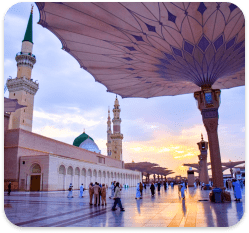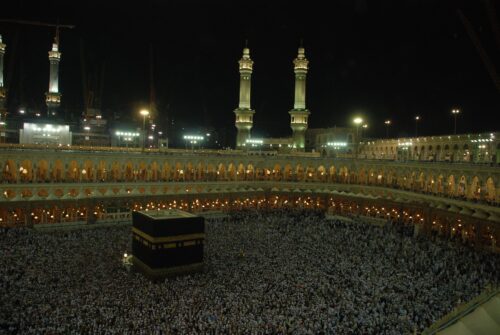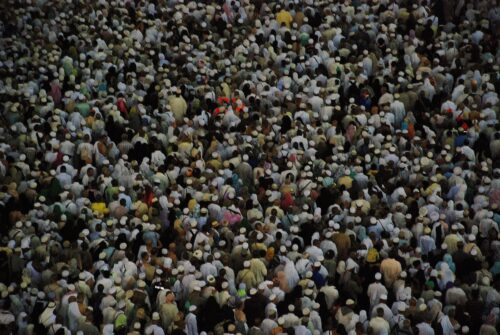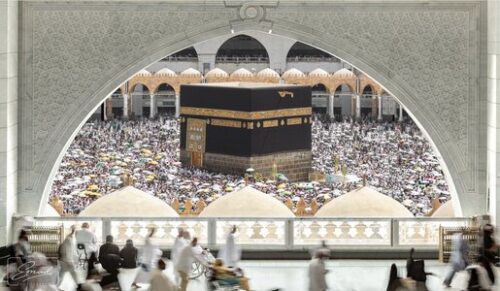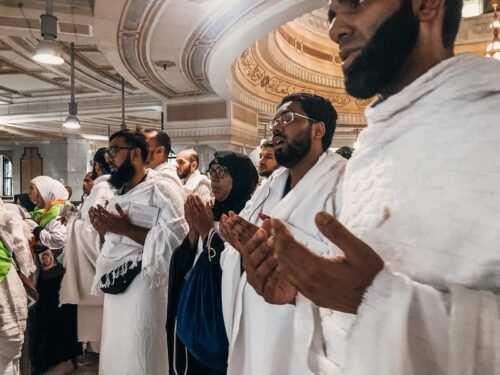Safa and Marwa – Everything You Need To Know
The religious obligations of Hajj and Umrah hold great significance in Islam. Every year, millions of Muslim pilgrims embark on these major religious journeys. The reward for performing Hajj and Umrah is immense, and with this sincere hope, Muslims strive throughout their life with a will to visit the House of Allah SW—the Holy Kaaba.
Both religious acts comprise a number of rituals and religious offerings. One of the well-renowned rituals of Hajj and Umrah entails walking or jogging between the hills of Safa and Marwa. This is an integral part of the Islamic ritual, and its significance cannot be denied. Here is everything you need to know about the Holy Hills of Safa and Marwa.
What Is Safa and Marwa?
 Located in the long galley that is a part of Masjid Al-Haram, Safa and Marwa are two small historical hills which are connected to the larger mountains, Abu Qubays and Qaiqan in Makkah, Saudi Arabia. Safa and Marwa are an integral part of the religious acts of Hajj and Umrah as Muslim pilgrims are commanded to walk between the two hills in order to commemorate Bibi Hajar’s (AS) commitment to her son, Prophet Ismail (AS), in such harsh circumstances and her unwavering devotion to the command of Allah SWT.
Located in the long galley that is a part of Masjid Al-Haram, Safa and Marwa are two small historical hills which are connected to the larger mountains, Abu Qubays and Qaiqan in Makkah, Saudi Arabia. Safa and Marwa are an integral part of the religious acts of Hajj and Umrah as Muslim pilgrims are commanded to walk between the two hills in order to commemorate Bibi Hajar’s (AS) commitment to her son, Prophet Ismail (AS), in such harsh circumstances and her unwavering devotion to the command of Allah SWT.
During the Umrah and Hajj pilgrimages, Muslim pilgrims are required to travel back and forth seven times between the mountains of Safa and Marwa. This ritual is commonly known as Sa’ee, linguistically meaning walking, pursuing, or striving. It is a Sunnah to perform Sa’I, and hence every pilgrim should perform the Umrah and Hajj correctly by embarking upon this ritual.
What Is the Distance Between Safa and Marwa?
The historical hills of Safa and Marwa are known as the symbols of Allah SWT. And so, for both minor and major pilgrimages, it is considered mandatory to run or walk between the two hills. The Holy Kaaba is the centre point between the hills of Safa and Marwa. Moreover, the estimated distance between Safa and Marwa is approximately 450 meters or 1,480 feet. However, when we talk about the seven rounds of Sa’I, the distance between the mountains is approximately 1.96 miles (3.15 kilometres).
Both the hills of Safa and Marwa and the path in the middle of both the hills are located in the long corridor, of Masjid Al-Haram, otherwise known as the Grand Mosque. The distance travelled from Safa to Marwa constitutes a major ritual of the Umrah and Hajj pilgrimage. The ritual of Sa’I is also a constant reminder that one will always be rewarded if one strives and remains patient in the way of Allah SWT.
Why Are Safa and Marwa Important in Islam?
The act of running between Safa and Marwa is one of the main rituals of Umrah and Hajj pilgrimages, making both the hills very much significant in the religion of Islam. According to the Islamic teachings, pilgrims are instructed to run between the mountains of Safa and Marwa as the same act was performed by Prophet Muhammad PBUH and his fellow companions during the farewell Hajj. Prophet Muhammad PBUH said, “If she (Hajar) had left the water (flow naturally without her intervention), it would have been flowing on the surface of the earth.”
The story of Safa and Marwa is a clear depiction of Bibi Hajar’s (AS) unwavering devotion and faith in Allah SWT and her commitment to her son, Prophet Ismail (AS), in such harsh circumstances. Therefore, pilgrims going to Umrah and Hajj are advised to remember this story while running back and forth between the hills of Safa and Marwa to commemorate Bibi Hajar’s (AS) love for her son and belief in Allah SWT.
In other words, the ritual of Sa’ee depicts the lifelong challenges that a person encounter. It also teaches us to remain steadfast, keep on trying and have faith in Allah SWT no matter how hard it gets as if he helped Bibi Hajar (AS) by making the impossible possible; he will help you as well. In short, the ritual of Safa and Marwa is a time for Muslims to meditate and reflect upon their presence in the physical world.
Where Are Safa and Marwa Located?
Safa and Marwa are two historical hills that are situated in the area of Masjid Al-Haram in the holy city of Makkah, adjacent to the Holy Kaaba. These two hills of Marwa and Safa are conjoined with the two bigger mountains of Qaiqan and Abu Qubays, respectively.
How Long Does It Take to Walk from Safa to Marwa?
The total distance between Safa and Marwa is 1.96 miles or 3.15 kilometres. It takes around 10 minutes to walk from Safe to Marwa and vice versa. However, the duration to recite the Quranic verses or make Dua at any of the two mountains is approximately 8 minutes. Therefore, according to our time estimate, it takes 2 hours and 45 minutes to complete the ritual of Sa’I- walks between Safa and Marwa seven times.
What to Recite Between Safa and Marwa?
 Although there is no specific set of prayers to recite as a pilgrim traverses from one mountain to another. A pilgrim may utter the following Dua when walking between Safa and Marwa. It should specifically be recited between Milayn al-Akhdharayn, this was also recited by Abdullah ibn Umar (RA):
Although there is no specific set of prayers to recite as a pilgrim traverses from one mountain to another. A pilgrim may utter the following Dua when walking between Safa and Marwa. It should specifically be recited between Milayn al-Akhdharayn, this was also recited by Abdullah ibn Umar (RA):
رَبِّ اغْفِرْ وَارْحَمْ، تَجَاوَزْ عَمَّا تَعلَمْ، إِنَّكَ أَنْتَ الْأَعَزُّ الْأَكْرَمُ
Rabb ighfir wa rḥam, tajāwaz ‘ammā ta’lam(u), innaka anta l-a’azzu l-akram.
“O my Lord, forgive, have mercy, and pardon that which You know. Truly You are the Most Mighty, the Most Noble.”
Thereafter, the following may be recited:
رَبَّنَا آتِنَا فِيْ الدُنْيَا حَسَنَةً وَّفِيْ الآخِرَةِ حَسَنَةً وَّقِنَا عَذَابَ النَار
Rabbanā ātinā fi d-dunyā ḥasanatan wa fi l-ākhirati ḥasanatan wa qinā ‘adhāba n-nār.
“O our Lord, grant us the good of this world, the good of the Hereafter, and save us from the punishment of the fire.”
The Safa and Marwa Story
The story of Safa and Marwa commemorates the struggle of, Bibi Hajar (AS), who ran between these hills 7 times seeking water for Prophet Ismail (AS), her parched son.
According to Islamic history, Prophet Ibrahim (AS) lived with his first wife, Sarah (AS), in Palestine. At that time, Bibi Hajar (AS) was a slave girl who was given to Sarah (AS) after her father’s demise. However, as years passed by, Sarah (AS) remained without a child, and so on his wife’s suggestion, Prophet Ibrahim (AS), tied the knot with the young slave girl Bibi Hajar (AS).
Soon after their union, Allah SWT blessed Bibi Hajar (AS) and Prophet Ibrahim (AS) with a beautiful son, Prophet Ismail (AS), who was to become the forefather of the blessed Prophet Muhammad PBUH and the father of the Arabs.
The divine command was soon revealed to Prophet Ibrahim (AS), as Allah SWT instructed him to leave his wife, Bibi Hajar (AS), and his only baby son, Prophet Ismail (AS), in the middle of a deserted and dry valley of Makkah. Following the Allah SWT’s command, Prophet Ibrahim (AS) left both his son and wife under a free with a few provisions and a waterskin, located between Safa and Marwa.
Although Bibi Hajar (AS) was initially a bit hesitant to stay all by herself in the middle of nowhere, however when she learned it was the command of the Almighty, she placed her trust and faith in Allah SWT and accepted His Will. Prophet Ibrahim (AS) then recited the Dua below after leaving his family in Makkah:
رَّبَّنَا إِنِّي أَسْكَنتُ مِن ذُرِّيَّتِي بِوَادٍ غَيْرِ ذِي زَرْعٍ عِندَ بَيْتِكَ الْمُحَرَّمِ رَبَّنَا لِيُقِيمُوا الصَّلَاةَ فَاجْعَلْ أَفْئِدَةً مِّنَ النَّاسِ تَهْوِي إِلَيْهِمْ وَارْزُقْهُم مِّنَ الثَّمَرَاتِ لَعَلَّهُمْ يَشْكُرُونَ
“Our Lord, I have settled some of my descendants in an uncultivated valley near Your sacred House, our Lord, that they may establish prayer. So make hearts among the people incline toward them and provide for them from the fruits that they might be grateful.”
[Surah Ibrahim, 14:37]
Not long after, the water in the bag ran out; as a result, the nursing mother could not produce milk. Moreover, as a consequence of feeling parched, Prophet Ismail (AS) started having seizures, seeing which Bibi Hajar (AS) desperately began foraging for water or food provisions nearby. Being desperate to find a water source, Bibi Hajar (AS) started climbing the mounts of Marwa and Safa to seek out any travellers passing through and scan the area.
She ran between the hills 7 times under the scorching sunlight before coming back to check on the condition of baby Ismail (AS), whom she had placed under the tree shade on the land to make her search easier and faster. That is when the worried and panic-stricken Bibi Hajar (AS) requested Allah SWT to save her baby’s life.
According to Islamic history, just then, by the command of Allah SWT, Angel Jibraeel (AS) came to their aid. Angel Jibraeel (AS) scratched the barren land with his wing (or heel as stated in some narrations), which lead to water miraculously emerging from the ground. The moment she saw the spring, Bibi Hajar (AS) began drinking from it and was thereafter able to feed baby Ismail (AS), hence saving her child’s life.
Bibi Hajar (AS) then used her hands to dig a well around the spring. Today this spring is called the ZamZam well. Angel Jibraeel (AS) also assured Bibi Hajra (AS) that she need not worry about their life, as Prophet Ibrahim (AS) and Prophet Ismail (AS) will construct the House of Allah SWT on that exact spot.
Shortly afterwards, a small group of travellers spotted bird flocks in the middle of nowhere. Understanding that birds congregate around sources of water, the group came to the Well of ZamZam and requested Bibi Hajar (AS) to drink from the well, to which she obliged. This small group of travellers belonged to the Jurhum tribe, who then settled and populated the same area.
Who Ran between Safa and Marwa?
Prophet Ibrahim’s (AS) wife Bibi Hajar (AS) ran between the hills of Safa and Marwa seven times in order to look for a water source nearby.
Why Do We Run between Safa and Marwa?
Following the Sunnah of Prophet Muhammad PBUH, the act of Sa’I represents Bibi Hajar’s (AS) search for water for her only son, Prophet Ismail (AS). According to some narrations, it is said that Angel Jibraeel (AS) struck his wing on the ground, which led to a spring of water that emerged.
Whereas, in other places, it is narrated that it was Prophet Ismail (AS) who, when struck or scratched his heel on the barren ground, resulted in miraculously outflowing the Well of ZamZam by the command of Allah SWT. Therefore, today pilgrims run between the Safa and Marwa hills seven times to honour the struggle of Bibi Hajar (AS).
Safa and Marwa Mentioned in the Quran
إِنَّ الصَّفَا وَالْمَرْوَةَ مِن شَعَائِرِ اللَّهِ ۖ فَمَنْ حَجَّ الْبَيْتَ أَوِ اعْتَمَرَ فَلَا جُنَاحَ عَلَيْهِ أَن يَطَّوَّفَ بِهِمَا ۚ وَمَن تَطَوَّعَ خَيْرًا فَإِنَّ اللَّهَ شَاكِرٌ عَلِيمٌ
“Indeed, Safa and Marwa are among the symbols of Allah. So whoever makes Hajj to the House or performs Umrah – there is no blame upon him for walking between them. And whoever volunteers good – then indeed, Allah is appreciative and Knowing.” [Surah al-Baqarah, 2:158]
Commentating on the aforementioned verse, Ibn Kathir (RA) writes:
“Whoever performs Sa’i between Safa and Marwa should remember his meekness, humbleness, and need for Allah to guide his heart, lead his affairs to success and forgive his sins. He should also want Allah to eliminate his shortcomings and errors and to guide him to the straight path.
He should ask Allah to keep him firm on this path until he meets death, and to change his situation from that of sin and errors to that of perfection and being forgiven, the same providence which was provided to Hajar.”
Summary – Safa and Marwa
The hills of Safa and Marwa are known as symbols of Allah SWT’s greatness. They are located a short distance from the Holy Kaaba in Masjid Al-Haram. The hills have a significant role in the Islamic obligations of Hajj and Umrah. Pilgrims are instructed to walk or jog between Safa and Marwa seven times to commemorate the struggle of Bibi Hajar (AS) as she searched for water in the desert and the miracle of ZamZam was revealed to her.
Explore this site and hundreds more from the three holy sites on IslamicLandmarks.com
